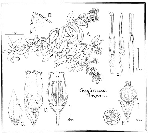Reference: SLEUMER, H. O., Die Gattung Gaylussacia H.B.K. Bot. Jahrb. Syst. 86(1--4): 309--384 (1967).

Shrubs or subshrubs. Leaves alternate, coriaceous to membranous, subimbricate or laxly-spaced, evergreen and persistent or deciduous, margin entire, glandular-crenate or subserrate, apex with a subsessile gland, pubescence simple, sometimes glandular, pinnately-nerved. Inflorescence axillary, racemose, or flowers solitary. Flowers 4--5-merous, without odor; (corolla) aestivation imbricate; calyx articulate with pedicel; hypanthium turbinate to hemispheric; lobes connivent or inflexed in fruit; corolla cylindric, urceolate, or campanulate, short-lobed, often 5-angled, white or red; stamen 10, equal, about as long as corolla; filaments distinct, shorter than anthers (rarely longer), almost always pilose and/or ciliate, lacking spurs; anthers dorsifixed above middle, lacking disintegration tissue; thecae smooth; tubules thin, dehiscing through narrowly oblong, lateral to subterminal pores; pollen lacking viscin threads; ovary pseudo- 10-locular; style equalling stamen or a little longer. Fruit a drupe with 10 pyrenes, carnose, succulent, and obtusely (8-) 10-ribbed when mature.
A genus of about 50 species from North America, then to N Argentina, and southeast Brazil.
One species: Gaylussacia loxensis.